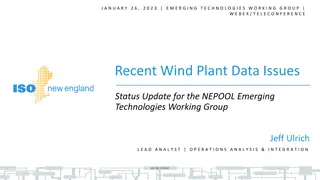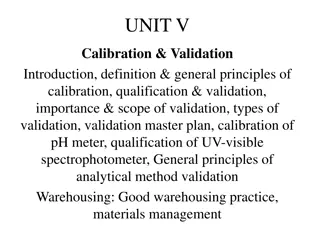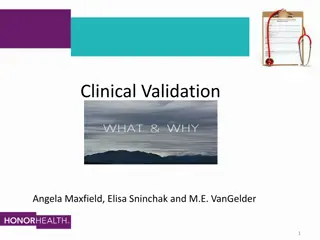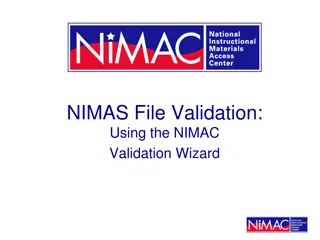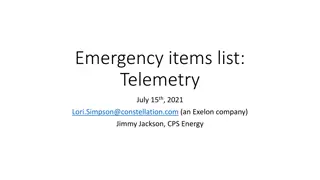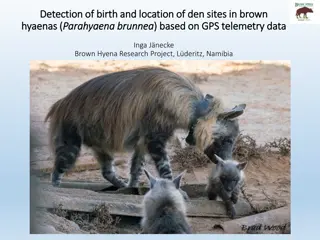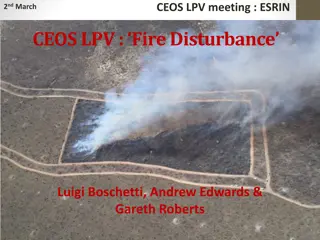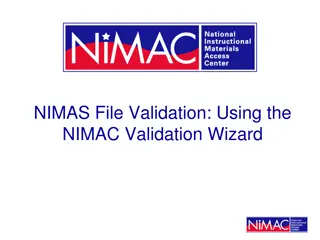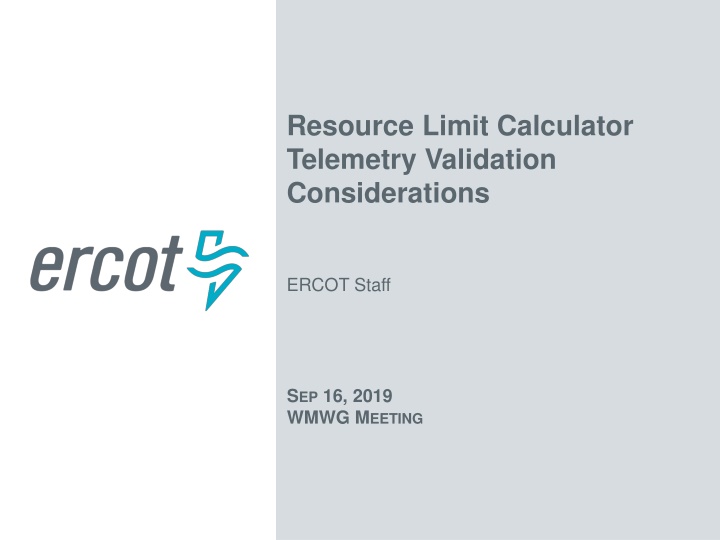
Telemetry Validation Considerations for Resource Limit Calculator - ERCOT Staff Meeting Recap
Explore the recent discussions at an ERCOT staff meeting regarding telemetry validations in the Resource Limit Calculator. Understand the considerations for aligning validations with operational standards and improving data quality for resource ramp rates and system-level markers. Stay informed about potential new alarms and offline statuses affecting resource output.
Download Presentation

Please find below an Image/Link to download the presentation.
The content on the website is provided AS IS for your information and personal use only. It may not be sold, licensed, or shared on other websites without obtaining consent from the author. If you encounter any issues during the download, it is possible that the publisher has removed the file from their server.
You are allowed to download the files provided on this website for personal or commercial use, subject to the condition that they are used lawfully. All files are the property of their respective owners.
The content on the website is provided AS IS for your information and personal use only. It may not be sold, licensed, or shared on other websites without obtaining consent from the author.
E N D
Presentation Transcript
Resource Limit Calculator Telemetry Validation Considerations ERCOT Staff SEP 16, 2019 WMWG MEETING
Recap At the Jun 24, 2019 WMWG meeting ERCOT provided an overview of the current telemetry validations in the Resource Limit Calculator (RLC). Slide Deck: Link At this meeting, Stakeholders requested ERCOT to holistically review the validations in RLC and identify any changes that would better align these to current operational standards. PUBLIC 2
Normal/Emergency Ramp Rate Telemetry Current If Suspect data quality is detected for resource ramp rates, then effective ramp rate is computed using the resource specific ramp rate curves as submitted in the resource s Market Manager Generation Resource Parameters or Resource Asset Registration Form (RARF) if there was no Market Manager Submission Possible Change Modify ERCOT internal procedures to update the low reasonability limit for telemetered ramp rates in ERCOT s SCADA to be 0 for all resources irrespective the submitted low reasonability ramp limit in the market system or RARF. When a suspect data quality is detected for resource ramp rates, retain the last telemetered value which had good quality instead of switching to market ramp rates. 3 PUBLIC 3
Possible New Alarm for Invalid QSE Telemetry When sudden large changes in System level markers like HDL-GEN, HASL- GEN etc. are detected, explore if impacts on actual frequency can be used to determine if the changes are valid and related to an operational condition or indicative of invalid telemetry from QSE(s). This condition when detected would raise an alarm, which will trigger post analysis. As the detection of invalid data using this logic becomes more robust, functionality maybe extended and other actions may be included as a part of this logic. 4 PUBLIC 4
Offline status with non-zero MW output Current Following conditions will trigger RLC to ramp down a resource per its SCED down ramp rate MW > 0.9*LSL and resource status is one of (OFF, OUT, EMR, OFFNS, EMRSWGR) Explore the following approach Enhance this logic check to ensure that the only time a Resource is dispatched, per its SCED down ramp rate, is when there is sufficient indication that the MW telemetry is unreasonable. In all other conditions, Resource will be locked at its current output (i.e., MW = LDL = HDL). 5 PUBLIC 5
Startup/Shutdown Sequence Current No special logic exists to ensure a resource follows a proper startup/shutdown sequence i.e. Off Startup ON or ON Shutdown OFF. Explore the following approach Explore additional logic to ensure startup/shutdown sequence is being followed appropriately and use this to derive how dispatch limits should be set when inconsistent telemetry is detected. 6 PUBLIC 6
Resource Status Telemetry Current When a Generation Resource telemeters a Resource Status code that is reserved for Load Resource/Controllable Load Resource (ex. OUTL), the dispatch limits continue to be calculated based on the dispatch limit logic (i.e. the Resource may be expected to move based on its ramp rate). Change to be implemented in October 2019 release When a Generation Resource telemeters a Load Resource only Resource Status, lock the Resource at its current output (i.e., MW = LDL = HDL). And vice versa. 7 PUBLIC 7
DISCUSSION PUBLIC 8 8
Current Telemetry Validations in Resource Limit Calculator ERCOT Operations JUNE 24, 2019 WMWG MEETING
RLC Overview RESOURCE LIMIT CALCULATOR SCED BP/LMP Data To QSE via SCADA/ICCP Telemetry from QSE via SCADA/ICCP ANCILLARY SERVICE CALCS. ex. HASL, LASL Calculated and telemetered Data To MMS/SCED RESOURCE LIMIT CALCS. ex. SURAMP, SDRAMP, HDL, LDL Dispatch Data from MMS GTBD CALCULATION Includes PLDRR, PWRR Data For Settlements Operator Initiated Data OTHER CALCS. Data For Reports and Compliance Ex. SCED Trigger following RRS release Protocol Section 6.5.7.2 drives the calculations and monitoring built into RLC today. RLC executes every 4 seconds. RLC uses telemetry from QSEs to compute limits such as HDL, LDL, HASL and LASL. These limits are then sent to MMS/SCED. RLC runs several sanity checks against input telemetry data and weeds out inconsistencies in telemetered data using pre-established business rules. 10 PUBLIC 10
Telemetry Validations in RLC SCADA Quality Check RLC has logic to handle telemetry SCADA data qualities of Good, Suspect, Manual Replaced and Uninitialized. ( intra -telemetry checks) If any resource specific telemetry data (excluding ramp rate related telemetries) from QSE has Suspect quality, then RLC retains the last good value which had telemetered quality Good and does not consider the new value of the telemetry that has Suspect data quality Thus, if bad data quality is detected for LSL or HSL, the last good value would be used. If Suspect data quality is detected for resource ramp rates, then effective ramp rate is computed using the resource specific ramp rate curves as submitted in the resource s Market Manager Generation Resource Parameters or Resource Asset Registration Form (RARF) if there was no Market Manager Submission 11 PUBLIC 11
Telemetry Validations in RLC Data Check The second layer of validation in RLC are is to ensuring telemetry data consistency across two or more resource specific telemetries. ( inter telemetry checks) Following conditions will trigger RLC to set HDL=LDL=MW HSL < LSL LSL < 0 HSL <= 0 AND resource status is not one of the offline statuses* HSL < Non-Spin Responsibility and resource status is OFFNS (HSL LSL) < Sum of AS Responsibility and resource status is not OFFNS Resource Status has invalid value but good SCADA quality Following conditions will trigger RLC to ramp down a resource per its SCED down ramp rate MW > 0.9*LSL and resource status is one of (OFF, OUT, EMR, OFFNS, EMRSWGR) Alarms are issued in case of most of the telemetry checks outlined above. * offline statuses = NA, OUT, OFFNA, OFF, EMR, OFFQS, EMRSWGR OR FRRSUP 12 PUBLIC 12
Resource Limit Calculator Logic Example 1 Input Values MW or # High Sustainable Limit (HSL) 0 - Actual Unit Capacity 550 Power Output (MW) 500 Normal Down Ramp Rate 200 - LDL=HDL=BP=500 500 Resource Status Code 3 (ON) Sum of AS Responsibilities 0 Low Sustained Limit (LSL) 0 Calculated Values MW High Dispatch Limit (HDL) 500 Low Dispatch Limit (LDL) 500 Output Values MW or # Base Point (BP) 500 Overridden Resource Status Code RLC Logic Applicable: Following conditions will trigger RLC to set HDL=LDL=MW HSL<=0 AND resource status is not one of the offline statuses* EMS Alarms triggered: Alert: TEL HSL BELOW 0 - Telemetered HSL = 0 13 PUBLIC 13
Resource Limit Calculator Logic Example 2 Input Values MW or # High Sustainable Limit (HSL) 0 - Actual Unit Capacity 550 Power Output (MW) 500 Normal Down Ramp Rate 200 500 Resource Status Code 13 (OFF) Sum of AS Responsibilities 0 Low Sustained Limit (LSL) 0 Calculated Values MW - LDL=HDL=BP=300 High Dispatch Limit (HDL) 300 Low Dispatch Limit (LDL) 300 Output Values MW or # Base Point (BP) 300 Overridden Resource Status Code 0 (NA) RLC Logic Applicable: Following conditions will trigger RLC to ramp down a resource per its SCED down ramp rate MW>0.9*LSL and resource status is one of (OFF, OUT, EMR, OFFNS, EMRSWGR) EMS Alarms triggered: Alert: TEL HSL BELOW 0 Alert: INCONSIST RST AND MW - Telemetered HSL = 0 14 PUBLIC 14
Resource Limit Calculator Logic Example 3 Input Values MW or # High Sustainable Limit (HSL) 0 - Actual Unit Capacity 550 Power Output (MW) 500 Normal Down Ramp Rate 200 500 Resource Status Code 0 (NA) Sum of AS Responsibilities 0 Low Sustained Limit (LSL) 0 Calculated Values MW - LDL=HDL=BP=300 High Dispatch Limit (HDL) 300 Low Dispatch Limit (LDL) 300 Output Values MW or # Base Point (BP) 300 Overridden Resource Status Code RLC Logic Applicable: HDL formula. No Special logic EMS Alarms triggered: Alert: TEL HSL BELOW 0 Alert: INCONSIST RST AND MW - Telemetered HSL = 0 15 PUBLIC 15
Discussion 16 PUBLIC 16
Resource Specific Telemetry From/To QSE* - Current From QSE Unit Related A/S Related High/Low Sustained Limits (HSL, LSL) AVR Status (AVR) FRRS Up/Down Participation Factor (FUPF, FDPF) Dynamically Scheduled Resource Schedule (DSRS)[Gen] Lower/Raise Block Status (LBST, RBST) [Gen] PSS Status (PSS) High/Low Emergency Limit (HEL, LEL) FRRS Up/Down Responsibility (FURS, FDRS) Normal Up/Down Ramp Rate (NURR, NDRR) Emergency Up/Down Ramp Rates (EURR, EDRR) Regulation Up/Down Participation Factor (RUPF, RDPF) Regulation Up/Down Responsibility (RURS, RDRS) Responsive Reserve Responsibility/Schedule (RRRS, RRSC) High Set Under Frequency Relay (HSUF) [NCLR] Net MW/MVAR (MW (aka NPF for CCP), MVAR) POI kV Measurement/Target (KVM, KVT) Gross MW/MVAR (GMW, GMV) Scheduled Power Consumption (SPC, SPC2) [CLR] Storage Resource Charge/Discharge Data (MXCP, MXDP, MXOD, SOC) IRR MET Data (DEG, IRAD, MPH, PRES, PTMP, TEMP) IRR Turbine/Panel Availability (NTOF, NTON, NTUN) Non-Spin Responsibility/Schedule (NSRS, NSSC) Resource Status (RST) CCP Config No (CCC) Non Frequency Responsive Capacity (NFRC) Load Resource Breaker Status (LRCB) [NCLR] Max/Low Power Consumption (MPC, LPC) [CLR, NCLR] To QSE Unit Related A/S Related Base Point (BP) Non-Spin Deployed (NDPL) Locational Marginal Price (LMP) RRS Deployed (RDPL) [NCLR] Curtailment (SBBH) SCCT Status (SCCT) Updated Desired BP (UDBP) *Refer to the ERCOT Nodal ICCP Communications Handbook http://www.ercot.com/services/rq/re 17 PUBLIC 17
Generation Resource Status Codes ONRUC (1) ONREG (2) ON (3) ONDSR (4) ONOS (5) ONOSREG (6) ONDSRREG (7) ONTEST (8) ONEMR (9) ONRR (10) SHUTDOWN (15) STARTUP (16) FRRSUP (17) ONOPTOUT (18) NA (0) OUT (11) OFFNS (12) OFF (13) EMR (14) OFFQS (19) EMRSWGR (20) *Refer to the ERCOT Nodal ICCP Communications Handbook Section 4.5.2 for more information on Resource Status Codes: http://www.ercot.com/services/rq/re PUBLIC 18 18
RLC Ancillary Service and Dispatch Calculations HASL LASL HDL LDL 19 PUBLIC 19
Alarms from RLC RLC issues the followings alarms as a result of its data sanity checks. HSL LSL is < AS RESP Alert: TEL HSL BELOW 0 Alert: TEL LSL BELOW 0 Alert: INVALID HSL SUM Alert: SCEDURR BELOW 0 Alert: INVALID CC CONFIG Alert: SUSPECT TEL HDL=LDL=MW Alert: INVALID TEL HSL OR LSL Alert: INVALID TEL RST Alert: INCONSIST RST AND MW 20 PUBLIC 20


